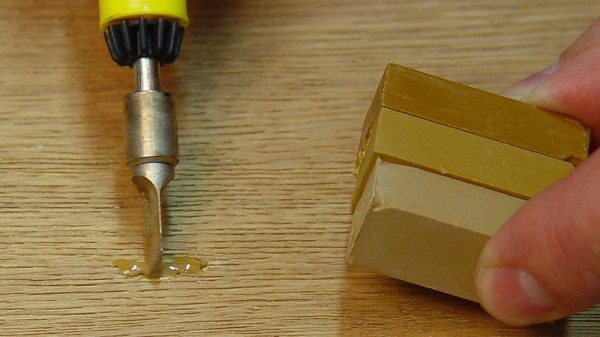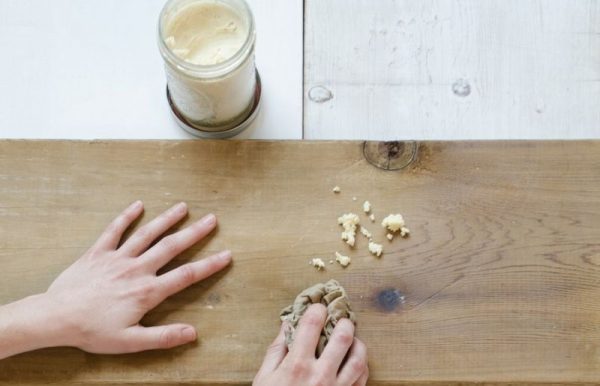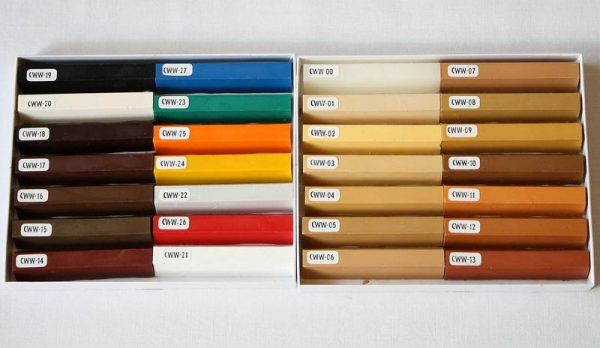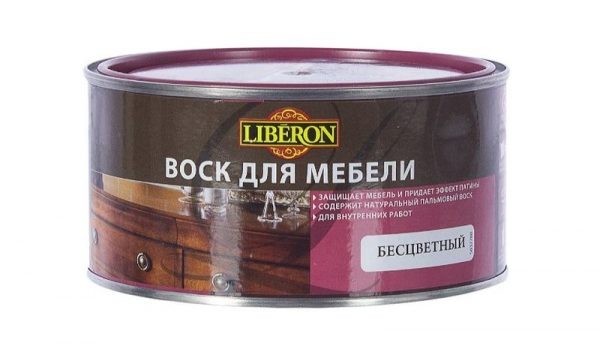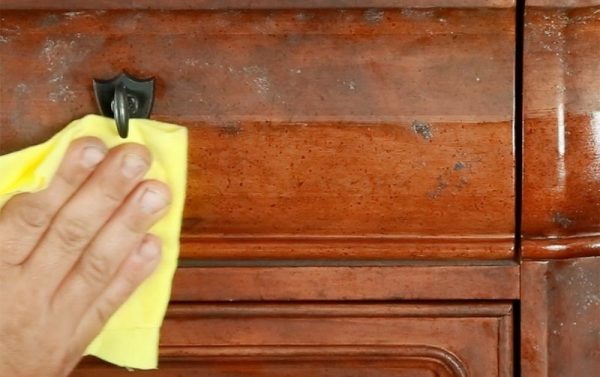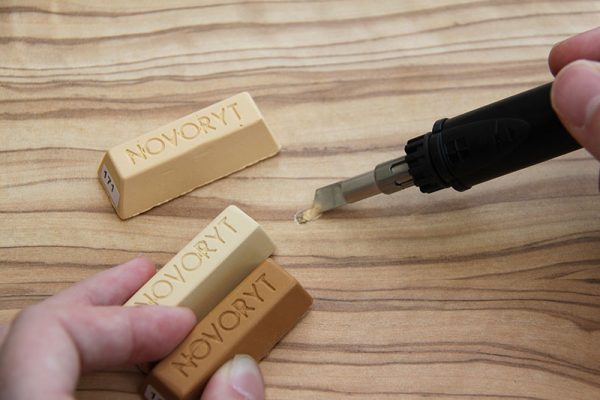Wooden furniture is incredibly popular among users. It is made from environmentally friendly, natural material, smells good, and lasts a long time. No less practical, while inexpensive are products from particleboard, laminate, MDF and other combined bases.
- Wax application
- Types of compounds
- Soft
- Solid
- Liquid
- Tool selection
- Instruction for use
- Pros and cons of using wax
- Do it yourself
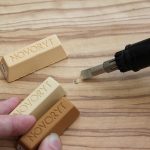
Despite its durability, any furniture deteriorates over time, deteriorates, and loses attractiveness. To update its appearance and extend its service, furniture wax was developed - a universal composition that hides minor defects and protects surfaces from moisture.
Wax application
Furniture wax is understood as a professional product based on natural waxes, resins and other components, intended for processing wood and lumber, as well as finished products and structures made of them. Most often, wax is used for furniture restoration: this is its direct purpose, which is prescribed in the instructions.
It is perfect for processing cabinet furniture, its wooden elements, providing such effects:
- concealment of damage, chips;
- closing cracks of any depth;
- giving a beautiful shine;
- enhancing the natural shade or toning of furniture;
- filling voids;
- improving the quality characteristics of wood.
The scope of the material is not limited to furniture repair. Its composition is perfect for working with other types of products and coatings.
The tool can be used for such purposes:
- Floor processing. If there are cracks in the wooden surface, furniture wax should be purchased to fill them. It is also suitable for rubbing into damaged parquet, laminate, because any floor coverings wear out during use, especially at increased load.
- Repair of decor items. With the help of wax, you can update the "appearance" of picture frames, caskets, tea houses, various wooden boxes and drawers, figurines and jewelry. For small-sized products, it is most convenient to use a tool in the form of a pencil. It will quickly remove the network of cracks, small scratches, return things shine and presentability.
- Restoration of windows and doors. Cracked, old windows and door leafs can be completely repaired with furniture wax, as well as give them a more saturated tone or change the natural shade.
to contents ↑
Types of compounds
Furniture wax is colored (pigmented) and colorless. Also, such products differ in the form of release, although the composition is almost the same - they contain carnauba and beeswax, wood resin, linseed, olive oil, drying oil and essential oils.
Soft
Wax, similar in texture to regular petroleum jelly, is best used to remove chips, scratches, cracks and dents of significant size on horizontal surfaces.It is suitable for both wood and laminated substrates, perfectly covers up traces of fasteners, accessories, masks downed corners on countertops and other products.
Soft material is sold in finished form, packaged in jars, buckets, tubes. It is squeezed onto the base or spread with a spatula, the excess is removed with a cloth or felt.
to contents ↑Most soft formulations have poor resistance to ultraviolet and atmospheric factors, and therefore are not suitable for outdoor use. Their color can be changed independently, diluted with transparent wax or mixed several shades.
Solid
Compositions in the form of pencils of different thicknesses, as well as in the form of crayons, pens are usually used for quick and convenient elimination of chips, scratches, cracks on vertical, inclined and horizontal bases. They are great for frames, doors, furniture, home decoration. The dense texture and resistance to adverse effects, temperature changes makes the tools suitable even for outdoor use. Some of them must be melted before use, others are applied like crayons without preparation.
to contents ↑Liquid
The composition of such products, in addition to natural resins, may contain synthetic components that allow maintaining fluidity. You can apply the material with a brush, brush, it easily penetrates into any cracks, scratches, chips, holes. The wax does not dry for long, is well absorbed, leaves no residue on the skin after drying. Outwardly, it resembles drying oil or a wax stain. Due to the nature of the structure, it is best to use it only on horizontal or slightly inclined bases.
to contents ↑Tool selection
When buying wax, you need to be guided by a number of rules. First of all, a specific problem is taken into account: if a small scratch appears on the furniture, it is easier to remove it with a wax pencil, if there is a large chip, you should buy a paste-like (soft) material. Also, when choosing, the shade of the product is carefully considered - it should be well suited to the color of the product itself, otherwise it will stand out on it as a spot.
Waxes for outdoor use must have powerful water-repellent properties and contain components that prevent them from fading from ultraviolet radiation. For restoration of a large surface or for a complete renovation of furniture, it is worth buying wax in a large container, which is much more profitable.
to contents ↑Instruction for use
To work with a soft composition, a rubber spatula, felt will be required, a sharp knife to open the package. First, prepare the surface so that it is clean and the pores of the wood open.
The defective place is cleaned of varnish (if it was applied earlier) with a solvent, washed from impurities, completely dried. To improve the absorbency of the composition are passed on the basis of sandpaper (in the direction of the fibers of the material).
After they act in this way:
- open the package with wax;
- they collect the tool with a small spatula;
- impose the composition on the site of damage, closing them a crack, scratch;
- rubbed with felt;
- the excess is carefully cleaned with the same spatula or knife;
- leave a means for drying for an hour;
- polish the surface again to give gloss.
As a rule, a hard pencil-shaped wax is used to treat a scratch without prior preparation. Some tools involve preliminary melting and subsequent infusion into a crack or other defect. In this case, you will need a soldering iron or a building hair dryer to work. If there are no such tools, you can use a gas burner or a lighter. Heated material is applied to the problem area, leveled with a spatula, after drying, polished with a soft cloth. The excess composition is removed with a blunt knife.
to contents ↑Pros and cons of using wax
Wax for furniture does not remain on the surface, but penetrates the structure of wood or other wood-based materials. It does not spoil the texture, while impregnating the pores of a tree, repelling moisture and reducing the rate of destruction of the material. Other benefits of using wax:
- pleasant to the touch velvety coating after drying;
- enhancing the color and expressiveness of the picture;
- the presence of various shades, the ability to change the natural tone of a thing;
- reliable filling of all defects - chips, cracks, scratches.
The disadvantages of such funds are few. Compared to varnishes, waxes have a lower protective force, and they will have to renew their layer more often. Some species deteriorate from the action of ultraviolet radiation, burn out, therefore, restoration work will need to be done regularly.
to contents ↑Do it yourself
There is a simple recipe for making wax for furniture yourself. You need to take 100 g of beeswax, grind and melt in a water bath. Enter 50 g of turpentine, continue heating the mass to a homogeneous state. Add 25 g of rosin and an arbitrary amount of propolis there (to give a pleasant smell to the product). After cooling, the mass can lubricate the furniture and polish it well with rags.
The quality of home-made wax is not inferior to the store wax. With its help, you can easily restore the appearance of old, damaged furniture, seriously saving on the services of craftsmen!

